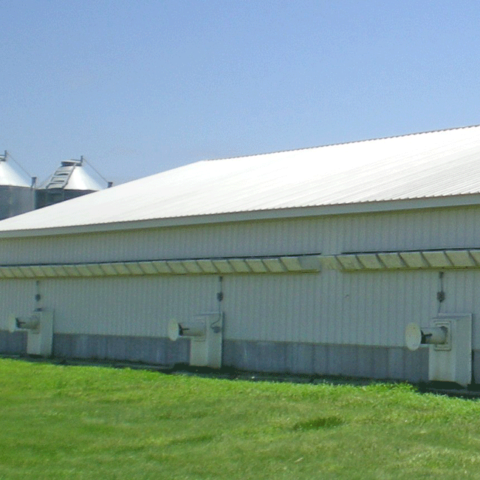
This blog is Part Three of our three-part series highlighting livestock ventilation system designs, with a focus on chimney vs. western-style mechanical ventilation systems. Follow the links for Part One and Part Two here.
Maintaining the health of your livestock is essential to a productive agricultural business, contributing to profitability by preventing disease and reducing animal discomfort and stress. Livestock ventilation systems are crucial in helping to keep your animals in peak condition while also maintaining good air quality for those who care for your livestock.
In the last blog, we covered the differences between natural ventilation and mechanical ventilation. Here, we take it a step further by diving into the differences between chimney ventilation systems and Western-style mechanical ventilation systems.
Chimney vs. Western-style Mechanical Livestock Ventilation Systems
Livestock ventilation systems also vary widely according to geography and climate, with larger facilities in the US tending towards more mechanization. Smaller production facilities in Europe and elsewhere rely more on natural ventilation that utilizes chimneys to move air through shafts that come out of the roof. Chimney livestock ventilation systems work well in structures where farmers cannot place inlets for air along the barn’s sidewalls.
In this type of system, air intake and exhaust occur through chimneys, which usually works on negative pressure, meaning the air pressure within the structure is lower than outside. In most cases, these exhaust chimneys are the only parts of the ventilation systems equipped with fans, pushing in clean air and pulling out dirty air through these vents. Because of this, these livestock ventilation systems allow farmers less control over conditions inside the barn.
In the United States, livestock ventilation systems advanced rapidly since the 1980s, tending towards engineered systems that micromanage climate within large structures that house thousands of animals. US animal farming has largely moved away from smaller operations, and structures housing animals tend to be more highly climate-controlled. Most mechanical livestock ventilation systems are designed for structures in which livestock are raised intensively, with many animals contained in tightly controlled climates. These tighter controls allow for lower morbidity among animals, even in confined conditions, and generally make the environment safer for both animals and workers.
Like chimney systems, the various mechanical livestock ventilation systems used in the US use negative pressure, with exhaust fans acting as pumps to help create a difference in pressure between the air inside and outside the structure. Air then moves in response to the pressure difference, from areas with higher pressure to those with lower pressure, ensuring fresh air throughout the barn.
Fans draw in fresh air through inlets and are used in conditions that are cold to mild. In warm to hot conditions, farmers also use sidewall and end wall curtains to take advantage of natural conditions. Modern systems also utilize attic space and ceiling inlets to draw in tempered air through the ceiling, using static pressure along with fan staging.
Mechanical livestock ventilation systems in the US depend on the ceiling and other inlets that require careful placement, sizing, and controls, all of which need to work well together to ensure proper ventilation. In fact, inlets are the most important part of these ventilation systems. These inlets provide a means through which air is distributed and moved evenly throughout the structure. Though fans move air around a facility, inlets that are improperly designed or placed usually are the cause of poor air quality within a barn.
In order to control the direction, speed, and condition of airflow, air inlets are carefully positioned. Wherever they are located, air inlets function to:
- Control airflow direction.
- Maintain sufficient air velocity through inlets.
- Provide fresh air throughout the structure
Attics in barns and other structures housing livestock tend to temper cold air before it enters the barn, mixing with inside air to create a warmer, more comfortable temperature. Knowing where to place inlets within a structure requires experience, as negative air pressure moves air naturally throughout the structure. This essentially creates a slight vacuum effect between inside and outside air, which requires very precise building construction. Most modern facilities housing animals have advanced control systems to maintain the environment within a comfortable range for the animals.
Along with these controls, the size, design, and placement of inlets help air move throughout the structure. Ventilation rates change by season, as inlets used during summer months require larger air volumes while colder weather focuses on bringing in less airflow from outside to maintain temperatures indoors.
Some inlets, like the Auto-MAX series by Osborne, are designed to respond passively to changes in pressure, moving in response to changing conditions to regulate airflow through free-swing baffles. Other inlets require manual adjustment to the size of openings to maintain consistent airspeed and fresh air within the barn. With either style, inlets are positioned high in the structure so that during the winter, incoming air mixes with the warmer air already in the building before dropping to the containment areas where animals are.
Contact the Experts at Osborne Livestock Equipment
Osborne has been an industry leader in the development of highly engineered, custom-designed, mechanical ventilation systems, and our ventilation experts are available to help design a complete system for new and existing livestock structures. Click here to learn more about the Agri-Aide Ventilation Systems we offer or contact us to get in touch with an engineer today.



